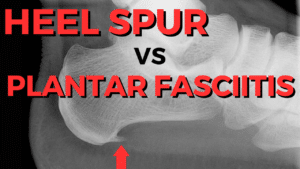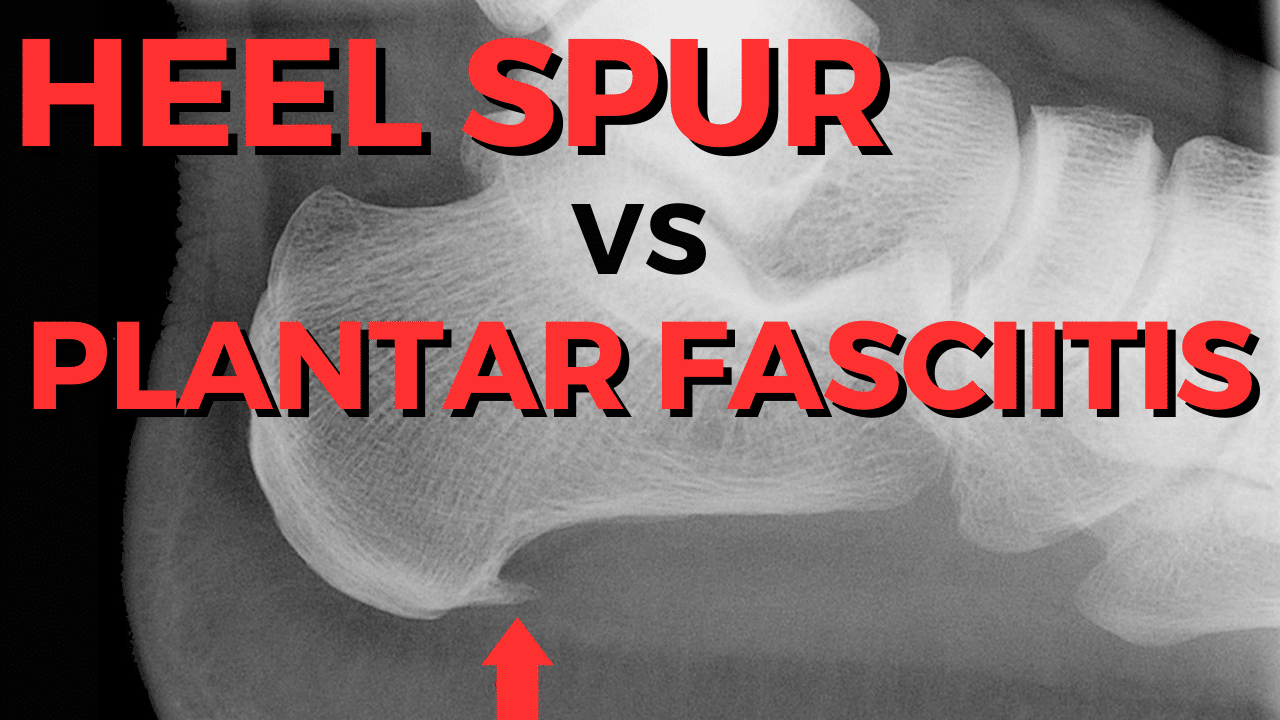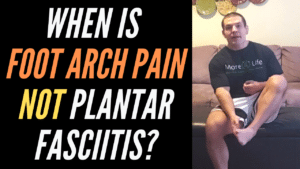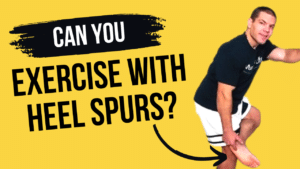
What's The Difference Between A Heel Spur vs Plantar Fasciitis?
Heel spurs and plantar fasciitis are different but related conditions. You can have a heel spur without having plantar fasciitis, and you can also have plantar fasciitis without having a heel spur.
In this post, you'll learn the difference between a heel spur and plantar fasciitis, plus tips you can use to relieve foot pain regardless of if it's from plantar fasciitis or a heel spur.

Heel Spur vs Plantar Fasciitis: What Are They?
The plantar fascia is a thick sheet of tendon-like connective tissue on the bottom of the foot. It's also referred to as the "plantar aponeurosis" as labeled in the image below.
As you can see from the picture, the plantar fascia attaches to the heel at the calcaneal tuberosity.
A "tuberosity" in antaomical terms is essentially just a bump of bone were tendons attach.
Sometimes when the tendons are pulling on the bone excessively, your body lays down new bone tissue to make the area stronger, which is known as a bone spur.
Therefore, a bone spur is a normal response to an abnormal force.
When that abnormal force occurs due to your plantar fascia pulling on your calcaneal tuberosity, that creates a heel spur.
What Causes A Heel Spur vs Plantar Fasciitis?
Heel spurs and plantar fasciitis are both caused by abnormal stresses on the foot.
One of the MOST common stresses is referred to as overpronation.
Your foot is supposed to flatten out, or pronate, slightly when you put weight on your foot.
However, excessively pronating your foot puts increased tension on the plantar fascia.
As a result, one or both of the following things can occur:
- The plantar fascia gets overstretched and develops microtears (plantar fasciitis)
- The plantar facia pulls excessively on the calcaneal tuberosity causing heel spurs
Diagnosis of Heel Spurs vs Plantar Fasciitis
Heel spurs are diagnosed using an x-ray as seen below:
What Does A Heel Spur Feel Like?
Take note that heel spurs ARE NOT always painful. There are many people who have heel spurs on their x-rays and don't have any foot pain.
However, when heel spurs ARE painful, they are usually very painful. The pain is sharp and usually pin-pointed right at the calcaneal tuberosity.
Heel spurs are usually most painful when walking on hard surfaces, especially if you walk with a heel-to-toe gait pattern.
Heels spurs can also be painful during exercises where you put weight through your heels likes squats or lunges.
What Does Plantar Fasciitis Feel Like?
On the other hand, plantar fasciitis pain is usually more diffuse and located more in the arch of the foot.
To truly diagnoses plantar fasciitis ("inflammation of the plantar fascia") you would need to have an ultrasound or MRI of the foot.
In most instances though, healthcare providers make a clinical diagnosis of plantar fasciitis from pain in the bottom of the foot that's worse with prolonged standing or walking or worse first thing in the morning.
However, it's important to note that not all foot arch pain is caused by plantar fasciitis.
Heel Spur Treatment vs Plantar Fasciitis Treatment
The good news is, it doesn't really matter that much whether or not your foot pain is caused by a heel spur or plantar fasciitis.
Remember, heel spurs and plantar fasciitis are both normal responses to abnormal forces.
Therefore, in order to treat both heel spurs and plantar fasciitis, you just have to figure out what the abnormal forces that are causing pain are, and then correct those problems.
As noted above, one of the most common problems is overpronation of your foot.
Insoles and Orthotics For Overpronation
One of the most common ways to control overpronation is wear shoe insoles or orthotics.
Many people with heel spurs try wearing gel heel cups to pad their heels.
However, that's not always the greatest option.
Why not?
- Many people with heel spurs and plantar fasciitis have stiff calf muscles. Wearing heel cups shortens your calf muscles and makes them stiffer over time.
- Heel cups don't fill your arch. Many people who develop heel spurs have high arches, so there's more pressure on the heel. While wearing a heel cup pads the heel, it doesn't fill the arch.
Often wearing a high-arch cushioned insole distributes the pressure more evenly across your foot rather than just on the heel and the ball of the foot.
Spenco Ground Control Shoe Insoles for W...
38% OffExercises For Heel Spurs
Doing exercises is another good way to treat heel spurs.
As I mentioned before, many people with heel spurs have stiff calf muscles, which causes them to overpronate when walking or running. Therefore, doing calf stretches is one good exercise for heel spurs.
Additionally doing balance exercises to strengthen your foot and ankle as well as to help you control your bodyweight overtop of your foot can also be helpful.
Finally, calf raises are a common exercise that people do for plantar fasciitis. While you do need to use your calves to push off while walking and running, it's important to keep your ankle in a neutral position while doing so. Learn how to do calf raises correctly in this post.
What Other Treatments Help Heel Spurs?
There are invasive treatments to break up or surgically remove heel spurs.
However, in most cases, those treatments AREN'T necessary.
Proper conservative treatment can help relieve pain from heel spurs and/or plantar fasciitis most of the time.
As with most medical issues though, you'll often get better and faster results working with a healthcare professional who is experienced in treating foot pain.
That's NOT always a podiatrist
Podiatrists will 99% of the time prescribe orthotics, and often that is a good treatment for heel spurs and plantar fasciitis.
However, podiatrists are also more likely to perform unnecessary foot surgery if orthotics alone don't help your heel pain.
One of the things podiatrists often DON'T address is the fact that there's a body attached above the foot.
The strength of your hip muscles and occasionally problems with your lower back can be other causes of overpronation.
That's why people often thing that plantar fasciitis is "difficult" to treat... because they don't address the factors outside of the foot, ankle, and calves.
Conversely, our physical therapy for plantar fasciitis addresses the biomechanics of your whole body when walking and/or running to help you get back to being active again without foot pain.
Need Treatment For Heel Spurs or Plantar Fasciitis?
If you'd like treatment for heel spurs or plantar fasciitis that addresses ALL of the factors contributing to your foot problem so that you can get better as quickly as possible and keep the pain from coming back, tap the button below to request an appointment with one of our specialists.








